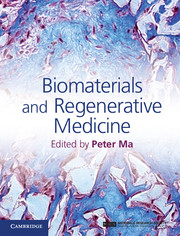Book contents
- Frontmatter
- Contents
- List of contributors
- Preface
- Part I Introduction to stem cells and regenerative medicine
- Part II Porous scaffolds for regenerative medicine
- Part III Hydrogel scaffolds for regenerative medicine
- Part IV Biological factor delivery
- Part V Animal models and clinical applications
- 25 Bone regeneration
- 26 Biomaterials for engineered tendon regeneration
- 27 Advancing articular cartilage repair through tissue engineering: from materials and cells to clinical translation
- 28 Engineering tissue-to-tissue interfaces
- 29 Models of composite bone and soft-tissue limb trauma
- 30 Tooth development and regeneration
- 31 Dentin–pulp tissue engineering and regeneration
- 32 Dental enamel regeneration
- 33 Hair follicle and skin regeneration
- 34 In-vitro blood vessel regeneration
- 35 Stem cells for vascular engineering
- 36 Cardiac tissue regeneration in bioreactors
- 37 Bladder regeneration
- Index
- References
36 - Cardiac tissue regeneration in bioreactors
from Part V - Animal models and clinical applications
Published online by Cambridge University Press: 05 February 2015
- Frontmatter
- Contents
- List of contributors
- Preface
- Part I Introduction to stem cells and regenerative medicine
- Part II Porous scaffolds for regenerative medicine
- Part III Hydrogel scaffolds for regenerative medicine
- Part IV Biological factor delivery
- Part V Animal models and clinical applications
- 25 Bone regeneration
- 26 Biomaterials for engineered tendon regeneration
- 27 Advancing articular cartilage repair through tissue engineering: from materials and cells to clinical translation
- 28 Engineering tissue-to-tissue interfaces
- 29 Models of composite bone and soft-tissue limb trauma
- 30 Tooth development and regeneration
- 31 Dentin–pulp tissue engineering and regeneration
- 32 Dental enamel regeneration
- 33 Hair follicle and skin regeneration
- 34 In-vitro blood vessel regeneration
- 35 Stem cells for vascular engineering
- 36 Cardiac tissue regeneration in bioreactors
- 37 Bladder regeneration
- Index
- References
Summary
Motivation for cardiac tissue regeneration in vitro
Myocardial infarction (MI) leads to the death of cardiomyocytes, and the infarct area becomes replaced by a fibroblastic scar tissue that has no contractile function. This reduces the pumping ability of the heart and the cardiac output. In addition, the scar tissue thins due to the lack of vasculature to provide oxygen and nutrients to the infarct site, thus leading to high wall stress and cardiac dilatation, which may ultimately lead to heart failure.
The adult heart has a limited regenerative capacity. The shortage of donor organs further suggests a need to develop new treatment strategies for cardiovascular diseases. Cardiac tissue regeneration can be achieved through several strategies, including (1) gene therapy, (2) cell transplantation, and (3) implantation or injection of biomaterials or engineered cardiac tissues. The goal of these cardiac tissue regeneration strategies is to repair the damaged myocardium through supporting vascularization and cell survival, in turn reducing wall thinning and preventing dilatation and heart failure. Gene therapy is not a specific topic of this chapter, in which the focus will be on bioreactors for cell expansion and engineering of cardiac tissues for cardiac tissue regeneration. Instead, we refer the reader to excellent reviews [1–3].
- Type
- Chapter
- Information
- Biomaterials and Regenerative Medicine , pp. 640 - 668Publisher: Cambridge University PressPrint publication year: 2014
References
- 1
- Cited by

